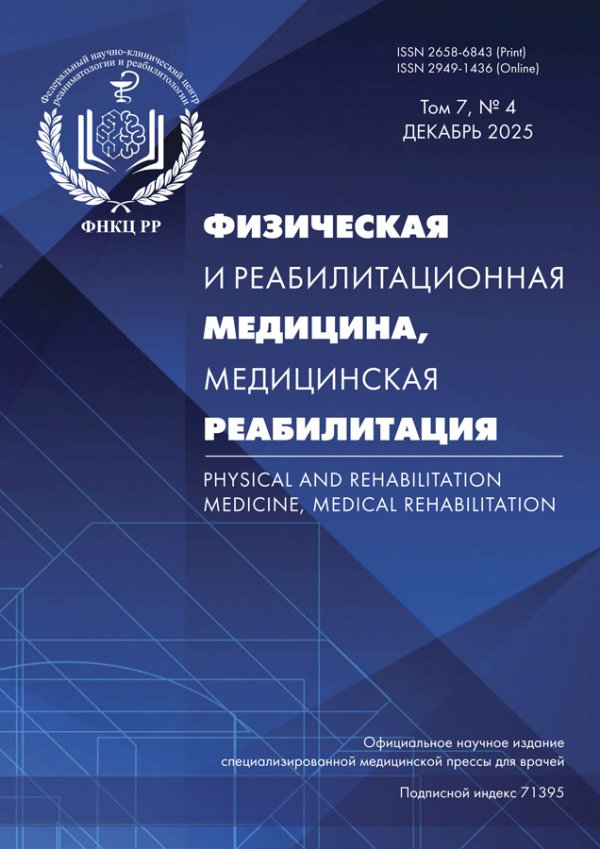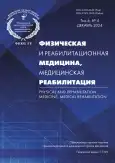Phenotype-associated efficacy of regression of post-stroke hand paresis immediately after a course of adjuvant repetitive transcranial magnetic stimulation in real clinical practice
- Authors: Zakharov Y.Y.1,2, Belkin A.A.1,2, Pozdnyakov D.G.1
-
Affiliations:
- Clinical Institute of Brain
- Ural State Medical University
- Issue: Vol 6, No 4 (2024)
- Pages: 312-323
- Section: ORIGINAL STUDY ARTICLE
- URL: https://journals.rcsi.science/2658-6843/article/view/277516
- DOI: https://doi.org/10.36425/rehab637432
- ID: 277516
Cite item
Full Text
Abstract
BACKGROUND: To enhance post-stroke motor recovery, integrating proven noninvasive brain stimulation techniques into clinical practice is essential. An important translational limitation is that phenotypes of beneficial response to noninvasive brain stimulation remain underdetermined.
AIM: This study aims to evaluate the strength of regression of post-stroke hand paresis following adjuvant treatment with repetitive transcranial magnetic stimulation in a real-world clinical setting, based on patient phenotype.
MATERIALS AND METHODS: The retrospective observational study involved 1,295 subjects (age: 23–83; men: 52.4%) with post-stroke hand paresis. Patients were divided into four phenotypes based on the motor deficit grade (Medical Research Committee (MRC) Scale for Muscle Strength) and resting motor threshold of the cortical representation of m. Abductor pollicis brevis in the affected hemisphere. They are Phenotype 1 (MRC grade 4-3 w/o resting motor threshold increase); Phenotype 2 (MRC grade 4-3 with an increased resting motor threshold); Phenotype 3 (MRC grade 2-0 w/o resting motor threshold increase); Phenotype 4 (MRC grade 2-0 with an increased resting motor threshold). Phenotype 1 and 3 subjects received adjuvant treatment with high-frequency repetitive transcranial magnetic stimulation of the affected hemisphere; Phenotype 2 and 4 subjects received low-frequency repetitive transcranial magnetic stimulation of the unaffected hemisphere. In the comparator group of each phenotype, noninvasive brain stimulation was not performed. Clinical efficacy was assessed immediately after the treatment based on an increase in MRC score by ≥1.
RESULTS: Increased clinical efficacy in repetitive transcranial magnetic stimulation groups was detected for Phenotypes 2 (p <0.022) and 4 (p <0.0002). An additional beneficial outcome is expected, on average, in every seventh (Phenotype 4) and ninth (Phenotype 2) treated patient. Phenotype 1 showed lower (p <0.031) clinical efficacy in the repetitive transcranial magnetic stimulation group versus the comparator group. Repetitive transcranial magnetic stimulation in Phenotype 3 subjects showed no adjuvant efficacy.
CONCLUSION: The study showed an increased strength of muscle weakness regression after repetitive transcranial magnetic stimulation in Phenotype 2 and 4 patients. The study showed that rhythmic transcranial magnetic stimulation affected the sanogenetic process of motor recovery in Phenotype 1 subpopulation. The study outlined prerequisites to identifying phenotypes in patients with post-stroke, non-paretic motor deficit.
Full Text
##article.viewOnOriginalSite##About the authors
Yakov Yu. Zakharov
Clinical Institute of Brain; Ural State Medical University
Author for correspondence.
Email: ya.zakharov@gmail.com
ORCID iD: 0000-0001-5605-011X
SPIN-code: 7945-6264
MD, Cand. Sci. (Medicine)
Russian Federation, Berezovsky; EkaterinburgAndrey A. Belkin
Clinical Institute of Brain; Ural State Medical University
Email: belkin@neuro-ural.ru
ORCID iD: 0000-0002-0544-1492
SPIN-code: 6683-4704
MD, Dr. Sci. (Medicine), Professor
Russian Federation, Berezovsky; EkaterinburgDmitry G. Pozdnyakov
Clinical Institute of Brain
Email: dg.pozdnykov@mail.ru
ORCID iD: 0000-0003-0496-1899
Russian Federation, Berezovsky
References
- Lefaucheur JP, Aleman A, Baeken C, et al. Evidence-based guidelines on the therapeutic use of repetitive transcranial magnetic stimulation (rTMS): An update (2014–2018). Clin Neurophysiol. 2020;131(2):474–528. doi: 10.1016/j.clinph.2019.11.002
- Fregni F, El-Hagrassy MM, Pacheco-Barrios K, et al. Evidence-based guidelines and secondary meta-analysis for the use of transcranial direct current stimulation in neurological and psychiatric disorders. Int J Neuropsychopharmacol. 2021;24(4):256–313. EDN: OHXDZX doi: 10.1093/ijnp/pyaa051
- Guo Z, Jin Y, Bai X, et al. Distinction of high- and low-frequency repetitive transcranial magnetic stimulation on the functional reorganization of the motor network in stroke patients. Neural Plast. 2021;2021:8873221. doi: 10.1155/2021/8873221
- Di Pino G, Pellegrino G, Assenza G, et al. Modulation of brain plasticity in stroke: A novel model for neurorehabilitation. Nat Rev Neurol. 2014;10(10):597–608. doi: 10.1038/nrneurol.2014.162
- Lin YL, Potter-Baker KA, Cunningham DA, et al. Stratifying chronic stroke patients based on the influence of contralesional motor cortices: An inter-hemispheric inhibition study. Clin Neurophysiol. 2020;131(10):2516–2525. doi: 10.1016/j.clinph.2020.06.016
- Hummel FC, Cohen LG. Non-invasive brain stimulation: A new strategy to improve neurorehabilitation after stroke? Lancet Neurol. 2006;5(8):708–712. doi: 10.1016/S1474-4422(06)70525-7
- Grefkes C. Fink GR. Reorganization of cerebral networks after stroke: New insights from neuroimaging with connectivity approaches. Brain. 2011;134(5):1264–1276. EDN: OLUBSZ doi: 10.1093/brain/awr033
- Sebastianelli L, Versace V, Martignago S, et al. Low-frequency rTMS of the unaffected hemisphere in stroke patients: A systematic review. Acta Neurol Scand. 2017;136(6):585–605. doi: 10.1111/ane.12773
- Harvey RL, Edwards D, Dunning K, et al. Randomized sham-controlled trial of navigated repetitive transcranial magnetic stimulation for motor recovery in stroke. Stroke. 2018;49(9):2138–2146. doi: 10.1161/STROKEAHA.117.020607
- Dodd KC, Nair VA, Prabhakaran V. Role of the contralesional vs. ipsilesional hemisphere in stroke recovery. Front Hum Neurosci. 2017;(11):469. doi: 10.3389/fnhum.2017.00469
- Jaillard A, Martin CD, Garambois K, et al. Vicarious function within the human primary motor cortex? A longitudinal fMRI stroke study. Brain. 2005;128(5):1122–1138. EDN: ILYNKX doi: 10.1093/brain/awh456
- McCambridge AB, Stinear JW, Byblow WD. Revisiting interhemispheric imbalance in chronic stroke: A tDCS study. Clin Neurophysiol. 2018;129(1):42–50. doi: 10.1016/j.clinph.2017.10.016
- Sankarasubramanian V, Machado AG, Conforto AB, et al. Inhibition versus facilitation of contralesional motor cortices in stroke: Deriving a model to tailor brain stimulation. Clin Neurophysiol. 2017;128(6):892–902. doi: 10.1016/j.clinph.2017.03.030
- Oldfield RC. The assessment and analysis of handedness: The Edinburgh inventory. Neuropsychologia. 1971;9(1):97–113. doi: 10.1016/0028-3932(71)90067-4
- Veldema J, Nowak DA, Gharabaghi A. Resting motor threshold in the course of hand motor recovery after stroke: A systematic review. J Neur Rehab. 2021;18(1):158. EDN: MFWRSJ doi: 10.1186/s12984-021-00947-8
- Rossini PM, Di Iorio R, Bentivoglio M, et al. Methods for analysis of brain connectivity: An IFCN-sponsored review. Clin Neurophysiol. 2019;130(10):1833–1858. doi: 10.1016/j.clinph.2019.06.006
- Rosso C, Lamy JC. Does resting motor threshold predict motor hand recovery after stroke? Front Neurol. 2018;(9):1020. doi: 10.3389/fneur.2018.01020
- Luft AR, Forrester L, Macko RF, et al. Brain activation of lower extremity movement in chronically impaired stroke survivors. Neuroimage. 2005;26(1):184–194. doi: 10.1016/j.neuroimage.2005.01.027
- Dobkin BH, Firestine A, West M, et al. Ankle dorsiflexion as an fMRI paradigm to assay motor control for walking during rehabilitation. Neuroimage. 2004;23(1):370–381. doi: 10.1016/j.neuroimage.2004.06.008
- Mezaki T. Dystonia as a patterned motor malflow. Med Hypotheses. 2017;105:32–33. doi: 10.1016/j.mehy.2017.06.021
Supplementary files









